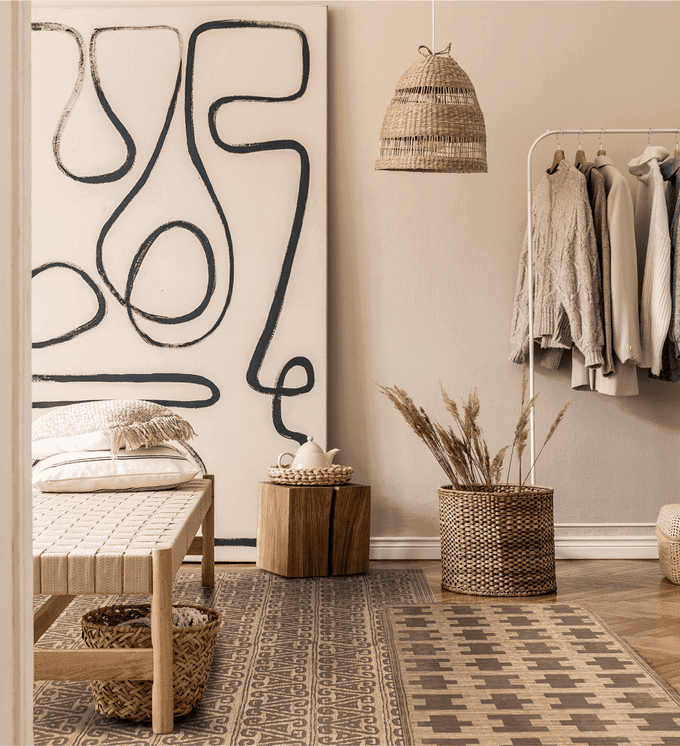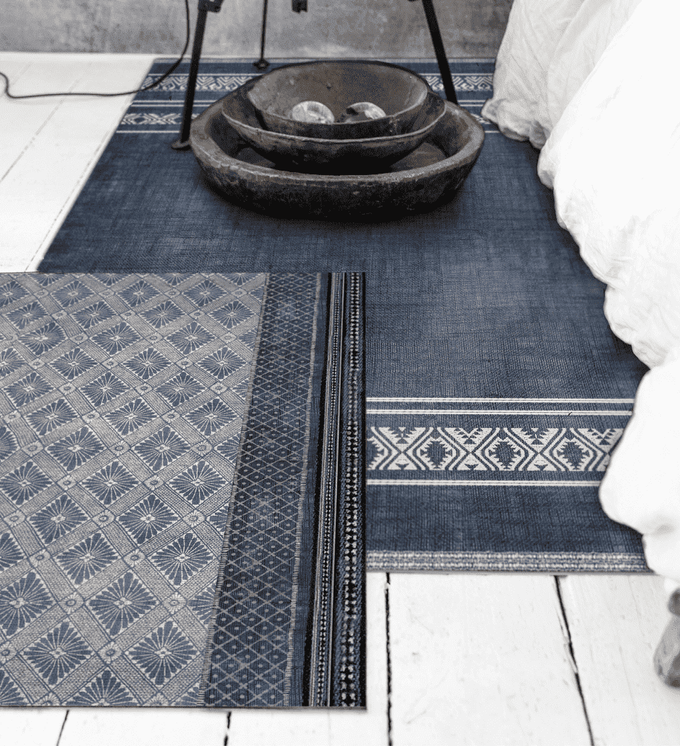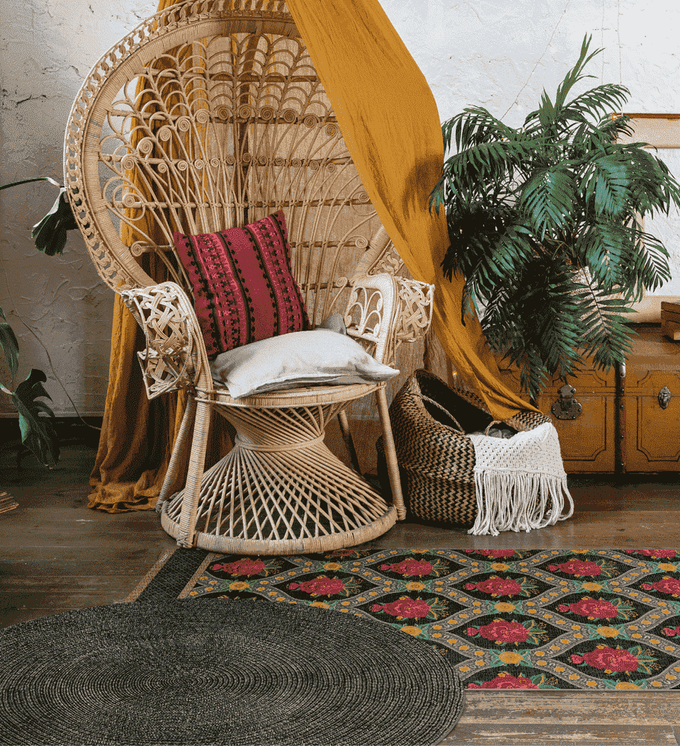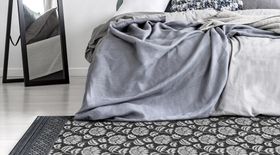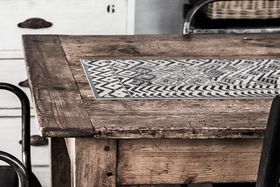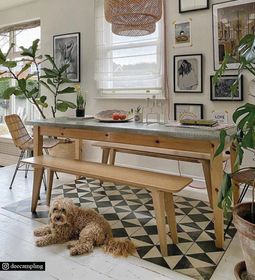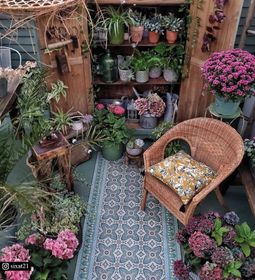How to Combine Rugs in Open Floor Plan Spaces
Updated March 2, 2023
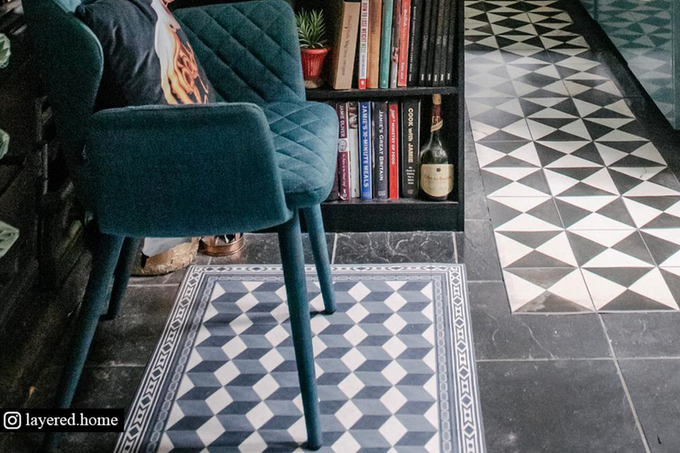
Whether you have a cool industrial loft space, a studio apartment, or a modern home with an open floor plan, these free-flowing layouts all pose the same design dilemma when it comes to selecting rugs: how to mix and match different rug styles without creating visual chaos?
Using multiple rugs in an open floor space such as a lounge, bedroom, or dining room will help distinguish those spaces and define individual style. The trick is to maximize on personality without creating clutter, and we'll show you some ways of doing so in this article.
Layer Small and Large
When using two rugs on top of one another in one room, the easiest solution is to pick opposing rugs—and by this, we mean the large rug at the bottom should have a plain, neutral tone, while the small rug on top should be colorful or patterned to provide the room with character and flair. This combination will allow each rug to be noticed and appreciated. Layering is popular décor choice because it adds more character, color, and depth to a space, showing there's more to the floor than just a plain old slab. However, the main tip for layering would be to consider a more flat-textured material such as vinyl to prevent a bulky effect on the floor.
» Try layering your rugs: browse our collections of large rugs and small rugs.
Mix Patterns and Colors
For a foolproof rug aesthetic, work within a consistent color scheme, but mix patterns and colors for a sense of complementary separation by allowing one rug to pull most of the visual weight. Using one splashy pattern and one solid rug is a clear way to center or divide functional areas. The balance between your two rugs can also create a sense of distance or draw attention to a focal point on one side of your home. It can work great if you want to focus on a specific part of the living room or the hallway with your rug. For a consistent feeling when mixing rugs in a room, you’ll generally want your patterned and solid rugs to share a color, even if they vary in tone. If you want a livelier juxtaposition, rely on complementary colors. A typical example of this is to pair an oriental-style rug with a relaxed jute rug.
» Get the perfect mix of patterns and colors with Bauhaus Indigo Concrete Rug
Try Some Hides
Hides can be a wonderful addition to an open floor plan—they add natural contrast in both texture and shape. However, it's important to choose your hide carefully, as the right one can add a sophisticated touch, liven up a simple space, and add a nature-inspired flair to the aesthetic of the room. Hides come in a wide range of colors and patterns, which gives you more freedom when choosing your preferred hide. You can also be bold and use 2 different hides to enhance the room's character.
» Get a hide for your open floor plan space: browse our collection of cow hide vinyl rugs.
Contrast Colors and Textures
In addition to the color palette, you can also create balance and contrast via texture—you can use contrasting materials and colors to define the different spaces by using a natural color as a base. For example, if the room has a beige or light-colored carpet, you can place vibrant, eye-catching rugs on it to break the monotony. The key is not to place too many rug colors or textures in a room, as this can make the décor seem messy and uncoordinated. Instead, you can introduce multiple different textures into the room by incorporating varied pieces of furniture.
Pair Round Rugs With Runners
Most of the time, when we think of rugs, your standard rectangular or runner springs to mind. Runners can bring warmth and charm to entryways and long hallways, making them more approachable and inviting, but round rugs definitely have their place too. What's more, they can easily be paired together with a runner, and the two shapes can define different areas of the space. They can work in parallel with furniture shapes as well—for example, round rugs for under a round table, and a runner for below a cabinet that sits against the wall. Aim for your runners and rugs to match but not copy one another, allowing each piece to maintain its uniqueness.
» Want to try this for yourself? Take a look at our selections of round rugs and runners
Combine the Past With the Current
When in doubt, juxtapose a modern abstract rug with an antique beauty, such as the Gambit rug. Pairing rugs with old-world patterns and designs with a modern, neutral color palette will keep things fresh and interesting and leave your room feeling balanced. Additionally, by adding an antique rug to a modern home, you're breaking the potential monotony of modern décor and creating a fresh, inviting space.
» Break the monotony of your open floor plan space with Gambit Antique Rug
Spice Up Your Open Floor Plan by Combining Rugs
An open-plan setting allows for freedom of exploration and generates unique ways to combine rugs to enhance the space and give it more personality.
Looking to spruce up your open-plan space? Visit our website for a variety of rugs, and see how to flair up any room with just a rug.

